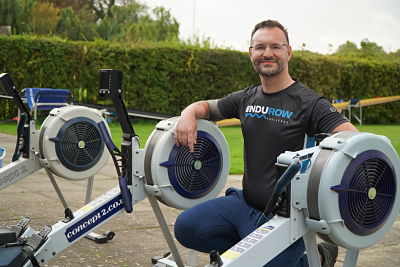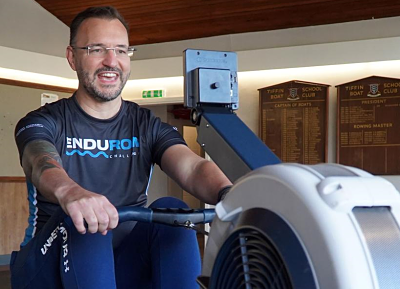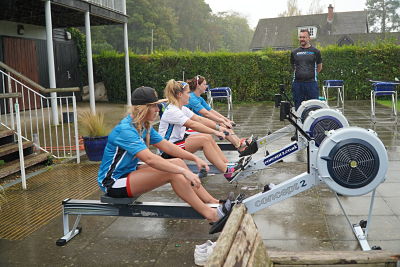EnduRow Challenge founder Steven Dowd was regularly using his 10-mile commute to work as an opportunity to get some cycling miles in his legs ahead of the 100-mile Ride London event in 2016.
Until one fateful morning, Steven’s life was changed forever. He hit a barrier, went over the handlebars and suffered an incomplete spinal cord injury which left him instantly paralysed.
Five years on, Steven tells us how hard work, support and goal-setting have helped him achieve his first 100-miler, complete a V-Everesting challenge in his own home, and create the world’s biggest indoor-rowing charity event…
Hi Steven, can you give us an insight into the journey you’ve gone on in the 5 years since your accident, from your initial emotions at realising you had no movement below the neck to setting yourself the goal of carrying the turkey to the table at Christmas?
‘Journey’ is certainly the right word! It’s one I’m still very much on.
I hit an almost invisible barrier blocking off a private road at exactly the right speed and angle to flip over the top. As I struck the asphalt head-first, my beautiful new electric blue helmet saved me from a brain injury but didn’t save me from breaking my neck and sustaining an incomplete spinal cord injury which left me instantly paralysed from the neck down.
Dazed, I didn’t realise what had happened at first and reached up to rub my bruised cheek but… nothing happened. Confused, I tried again. Still nothing. That’s when the sheer horror that I couldn’t move ANY part of my body dawned on me. I panicked but couldn’t do anything.
I was blue-lighted to hospital and, after undergoing several tests, I was approached by a consultant who told my wife Helen and I:
I’m sorry Mr Dowd. The injury is devastating. We don’t know if you’re going to recover from this.
I pictured myself being wholly dependent on others for the rest of my life and, honestly, I didn’t want that to be my future.
In the next breath the consultant told me of an experimental clinical trial being run at that time. There were only 50 places and the catch was, because timing was a crucial part of the criteria, I had an hour to decide. There were no promises but I figured I was just a pair of eyes on a pillow so they couldn’t make it worse. It took minutes for me to say, “I’m in!”.
I was in-and-out of surgery within 24 hours and after a couple of days I started to get some sensation back. I was getting pins-and-needles in my upper body that were so intense it felt like I was on fire. Drugs didn’t touch the pain.
My mindset was to treat any change like a win though. I might be on fire but I had nothing at all the day before so I saw it as progress! It was at that point that I made a promise to Helen that I’d be “back to normal” by Christmas Day, just 200 days away, and used that promise as my daily motivation to improve.

I tried and failed a thousand times to make my first tiny movement; a twitch of the thumb of my left hand. When it happened I couldn’t believe it but when I managed to do it again I was elated, and redoubled my efforts. Gradually different things started coming back and my movements got bigger and stronger.
After 4 months in hospital I was released home where I continued daily physio and, with the help of my amazing family, friends and the professionals, made incremental, daily wins on the way toward that bold goal.
Christmas Day 2016 arrived. I’m standing in the kitchen. I can hear the family laughing and joking in the dining room next door. A heavy turkey on a silver platter sits in front of me. It smells amazing!
I smile to myself at being in the very moment I’d pictured so vividly for the last 200 days through the most challenging times of my life. I reach down and grab the handles, lift the bird and slowly begin to walk the turkey to the Christmas table.
Amazing! I understand the 200-day goals have become something of a theme since as you’ve completed some ambitious challenges since?
200 days is a good amount of time for anyone to achieve something significant.
After the Christmas Day ‘turkey’ moment, I’d achieved the thing that had consumed me every day since the summer. So, what next? I needed a new goal to stay motivated.
I had unfinished business with cycling and wanted to ‘beat the thing that beat me’ so worked out that 200 days later fell the next Ride London event!

There was no way my wife would let me take part on the road so I decided I’d get back on the very same bike I had my accident on (it even still has the same broken brake lever) and cycle those 100 miles on Zwift on the same day as the event. It was a great opportunity to tackle a personal challenge and use it as a way to raise money and awareness for spinal cord injury research. It became known as the #200DaysChallenge.
Despite only ever cycling 17 miles in one go even before my accident, I set myself a goal for completing the 100 miles in 6 hours. I started training and on the day of the event I had a plan of holding 18mph average and just keep going, hydrating and refuelling at regular intervals. Unbelievably, I crossed the line at 5 hours 59 minutes and 40 seconds, beating my goal by just 20 seconds!
Once you'd conquered the 100 miles, you signed up for an Everesting challenge and scaled the height of Mount Everest from your own home. How did you get through that?
The #IsolationEverestChallenge was an incredibly tough one. So painful, physically demanding and dull for large portions of time. I had no real concept of how high Everest is nor how my body would respond so some homework showed I had to conquer 8,848m of elevation on my stairs and I’d need regular breaks.
I planned it out as 12-hour shifts of 25 mins-on / 5 mins-off. I had 3,881 upward flights to cover - I didn’t count the downward steps as only elevation counted. That’s a climb of over 46,500 ‘up’ steps and although my target pace was reasonable it was really hard to keep up.
I taped a secret motivational message from friends and family to my snacks and drinks which I’d look at every 2 hours during the challenge, figuring they’d keep me going for an hour and then I’d only have an hour to the next reward to keep pushing toward.
Even just hitting pace with each session was a quiet ‘high-five’ moment with myself and offered a little surge of endorphins. I find rewarding mini goals on the way to a bold ambitious goal are crucial. It’s essentially the same technique I used when overcoming my paralysis in those early days.
My balance isn’t great and my muscles spasm uncontrollably sometimes so there were a few hairy moments. I mostly fell up the stairs picking up the odd carpet burn and only slipped on the way down a couple of times, which focused my wandering mind.
In v-summiting Everest I became the first quadriplegic to do so, which I’m very proud of.

Fantastic work, Steven. And you’re now heading up the EnduRow Challenge. What are your goals with this event specifically?
EnduRow Challenge was sparked as an idea at the top of my stairs. I was talking to a journalist about having just v-summited and she asked, “so what’s next?”.
I wasn’t quite ready for that as my mind was still on what I’d just done, but I said “another static endurance event probably. Maybe something to do with indoor rowing?”. I’m not a rower but the wheels started turning over the following days.
It was clear to me that Covid-19 was affecting everyone everywhere. People across the world were locked down and facing similar challenges; fear, confusion, anxiety, isolation… No one knew what was happening, where it was going, when they’d be able to get back on track. It was a physically and emotionally precarious time for everyone.
I asked myself “how can I help make a real difference? How can I help everyone everywhere pull together through difficult times?” A global community event using indoor rowing seemed like the perfect way to do it. I began sketching the idea of a new endurance event. It had to tick a few boxes…
- Fully Inclusive (no barriers to entry to adults, kids, able-bodied or disabled)
- Indoor rowing endurance challenge (distance-based competitive event which separates people by ability but involves a meaningful time challenge of 4 hours which could be done solo or in teams)
- Worldwide (for everyone everywhere)
- Livestreamed (happening simultaneously around the world so we were all rowing together with a dedicated ‘show’ to watch)
- Charity fundraising

I started doing some networking and began making what turned out to be several hundred video calls with people in and around rowing to see if there would be any interest. To my delight there was plenty of traction for this unique idea and I soon gained valuable contacts and support from people at the top of rowing. I even got Sir Steven Redgrave on a 10-episode podcast series I designed to draw attention to the event and increase participation. A real honour and great fun to do in the build-up.
It became a full-time job, taking me months to arrange all the people, supporters, media, socials, and tech. Thankfully my efforts and enthusiasm to build “the world’s biggest, live-streamed, fully-inclusive indoor-rowing charity event” captured the enthusiasm of others also wanting to help and a small cadre of volunteers joined me to build the dream.
On the 6th February 2021 for four wonderful hours we had 1000 people across 11 countries row together and fundraise £27,000 for spinal cord injury research.
And what are your plans for the event in 2022?
If it were to be successful I wanted to make this an annual event benefitting a different charity each time. It was, and we are…
So, the next event, EnduRow Challenge ‘22, will be broadcast on 5th February at 1200-1600 GMT.
This time we are fundraising for Para Rowing Foundation (who help those with impairments around the world become the best athlete they can be through rowing). We are also encouraging people to row together in MacRows (completing the challenge in group environments e.g. your local gym) where safe to do so and following Covid guidelines, or as a MicRow (i.e. a solo challenge).
You can find out more about EnduRow Challenge '22 and enter here.